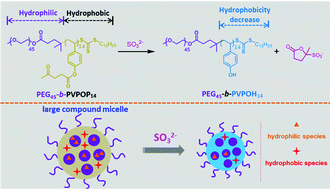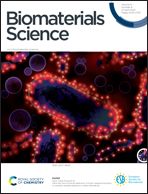Sulfur dioxide signaling molecule-responsive polymeric nanoparticles†
Abstract
Stimuli-responsive polymer nano-capsules toward a specific signaling molecule show great potential in the fabrication of smart and efficient controlled/targeted drug vehicles. Herein, we design and synthesize a PEG45-b-PVPOP14 diblock copolymer (PEG = poly(ethylene glycol) and PVPOP = poly(4-vinylphenyl 4-oxopentanoate), the subscripts representing the number of repeat units of each block) with levulinate-protected phenol side groups. The PEG45-b-PVPOP14 diblock copolymer could self-assemble to form large compound micelles in aqueous media. Since the core of the large compound micelles formed contains both hydrophilic PEG and hydrophobic PVPOP domains, this kind of micelle is able to load both hydrophobic and hydrophilic species within the core. The ester moiety of levulinate-protected phenol can be selectively cleaved upon incubation with a sulfite, a derivative of SO2 in aqueous media, to give phenol groups. Thus, the sulfite exhibits the ability to alter the amphiphilicity and further the self-assembled behavior of PEG45-b-PVPOP14. The release of payloads in the core of micelles can be accelerated by triggering of the sulfite. Significantly, the nano-capsule of PEG45-b-PVPOP14 shows specific response to the sulfite (SO2) with slight interference of other bio-species, such as Cys, GSH and Hcy. As far as we are aware, this is the first example of a nano-capsule with sulfite (SO2) specific responsiveness. We envisage that this polymer model could broaden the scope of biological signaling molecule responsive macromolecular systems and provide a new platform to fabricate SO2-responsive biomedicine materials.



 Please wait while we load your content...
Please wait while we load your content...